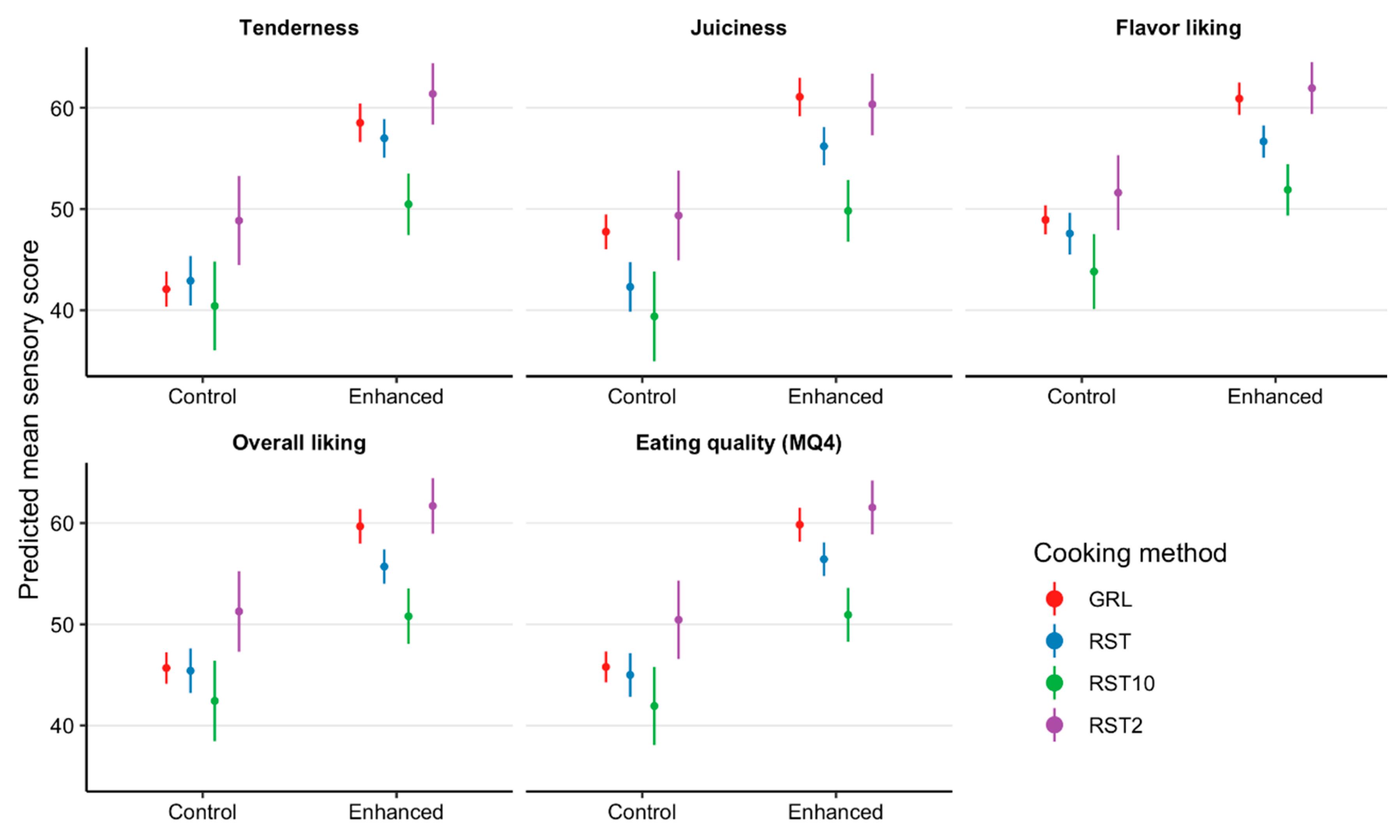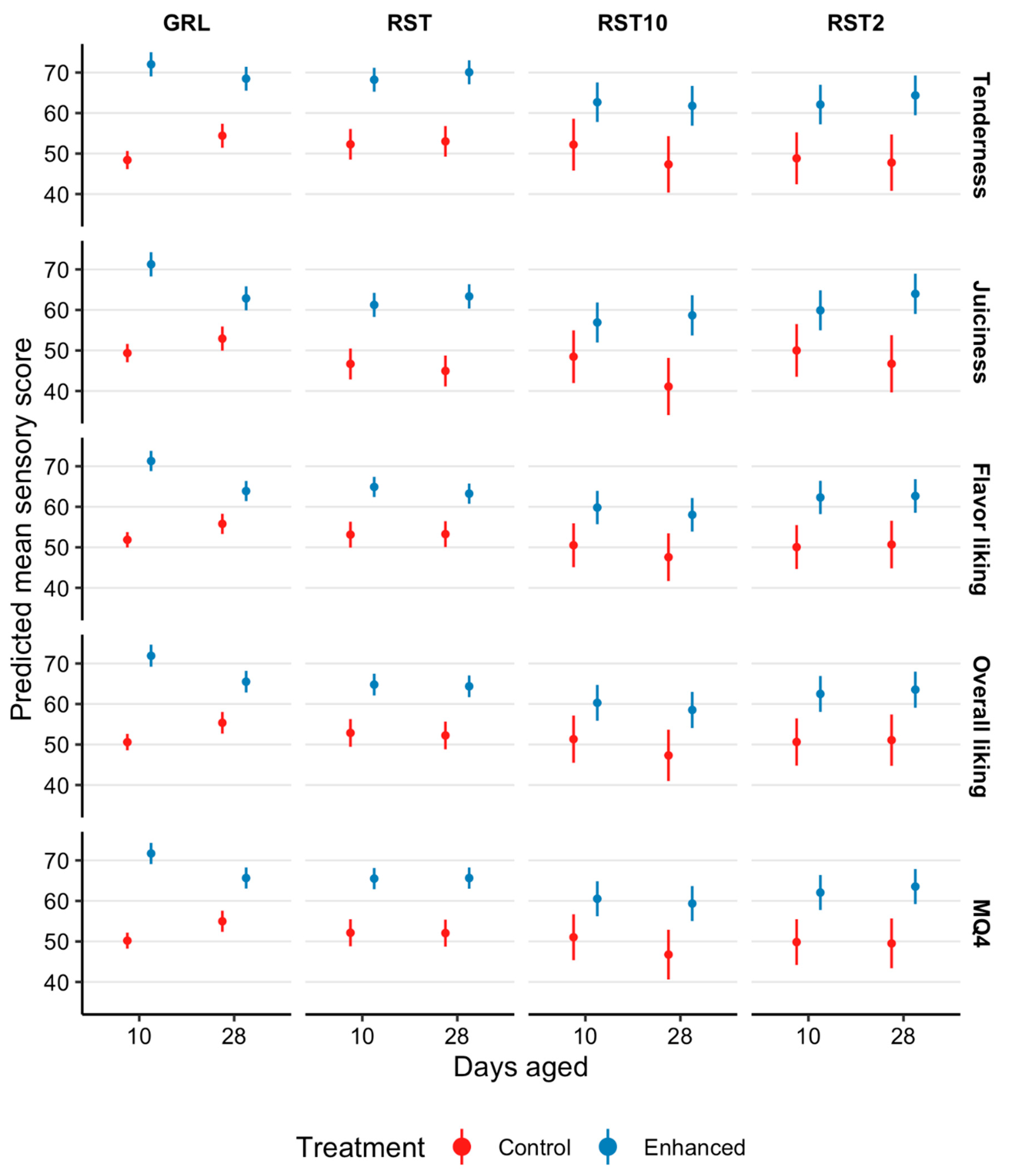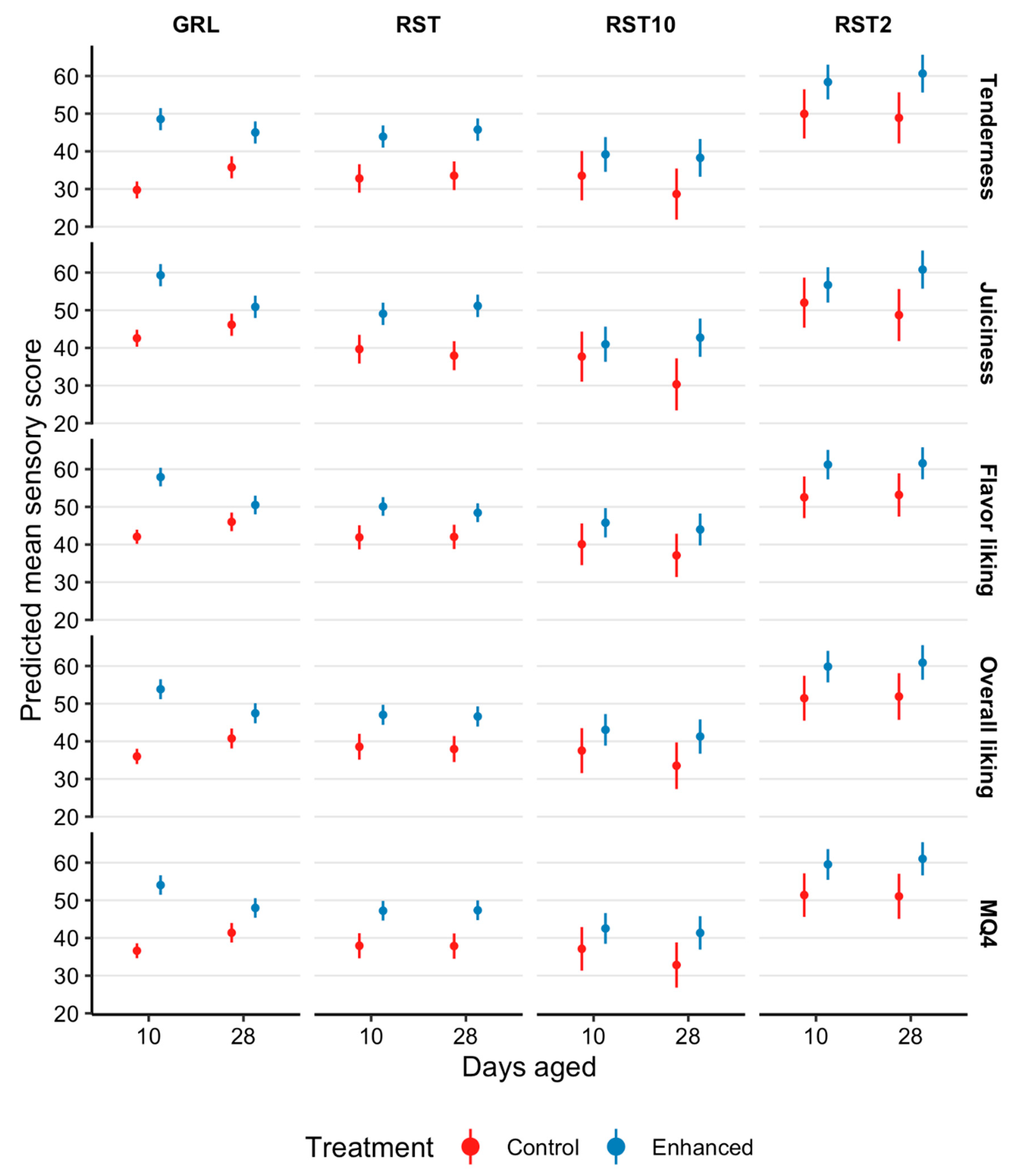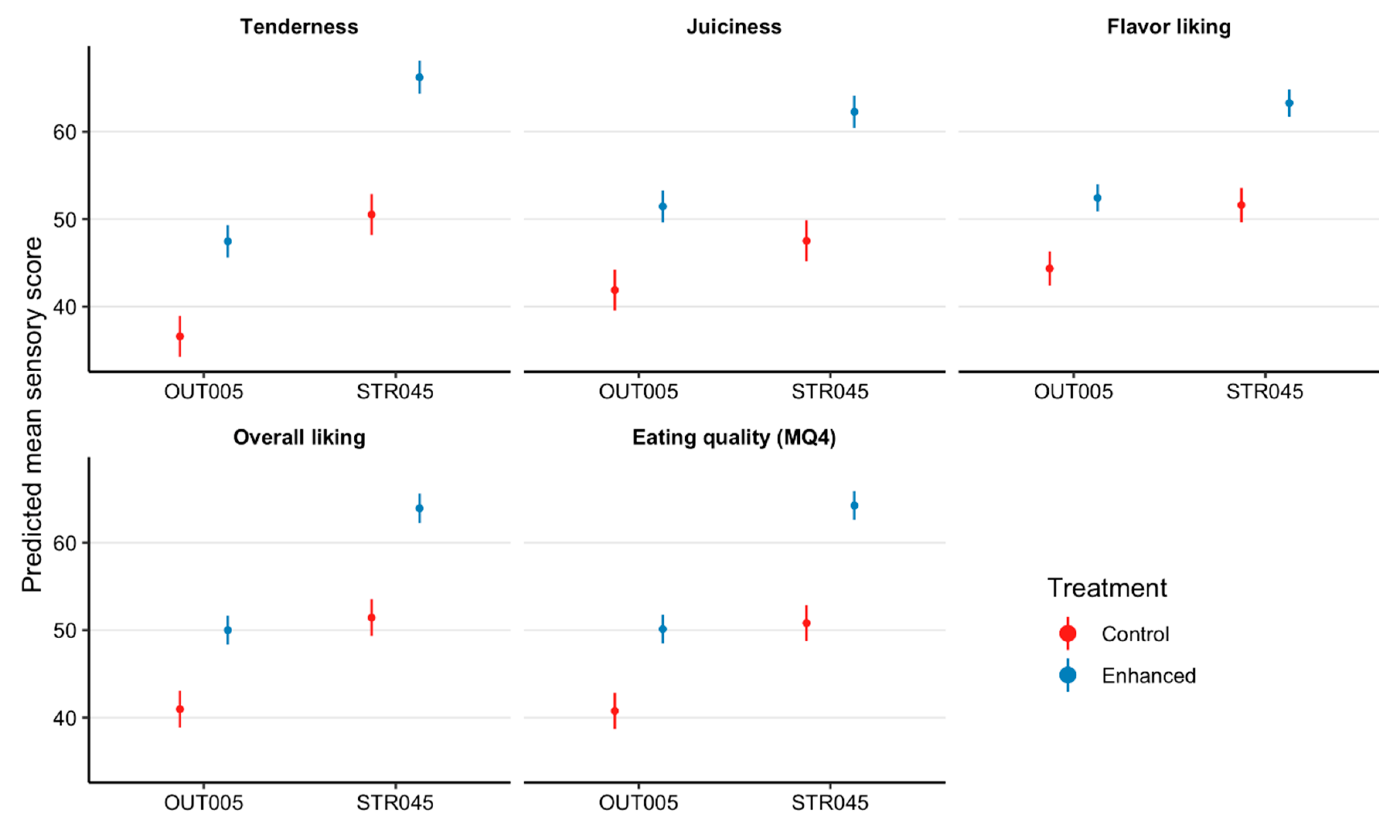Influence of Kiwifruit Extract Infusion on Consumer Sensory Outcomes of Striploin (M. longissimus lumborum) and Outside Flat (M. biceps femoris) from Beef Carcasses
Abstract
:1. Introduction
2. Materials and Methods
2.1. Animals
2.2. Slaughter Procedure, Carcass Grading, and Muscle Collection
2.3. Muscle Preparation
2.4. Consumer Sensory Testing
2.5. Statistical Analysis
3. Results
3.1. Carcass Traits
3.2. Kiwifruit Extract Infusion
3.3. Consumer Sensory Outcomes
4. Discussion
5. Conclusions
Author Contributions
Funding
Acknowledgments
Conflicts of Interest
References
- Lyford, C.P.; Thompson, J.M.; Polkinghorne, R.; Miller, M.F.; Nishimura, T.; Neath, K.; Allen, P.; Belasco, E.J. Is willingness to pay (WTP) for beef quality grades affected by consumer demographics and meat consumption preferences? Australas. Agribus. Rev. 2010, 18, 1. [Google Scholar]
- Polkinghorne, R.; Thompson, J.M.; Watson, R.; Gee, A.; Porter, M. Evolution of the Meat Standards Australia (MSA) beef grading system. Aust. J. Exp. Agric. 2008, 48, 1351–1359. [Google Scholar] [CrossRef] [Green Version]
- McGilchrist, P.; Polkinghorne, R.J.; Ball, A.J.; Thompson, J.M. The Meat Standards Australia Index indicates beef carcass quality. Animal 2019, 13, 1750–1751. [Google Scholar] [CrossRef] [PubMed]
- Polkinghorne, R.; Watson, R.; Thompson, J.M.; Pethick, D.W. Current usage and future development of the Meat Standards Australia (MSA) grading system. Aust. J. Exp. Agric. 2008, 48, 1459–1464. [Google Scholar] [CrossRef]
- Thompson, J. Managing meat tenderness. Meat Sci. 2002, 62, 295–308. [Google Scholar] [CrossRef]
- Watson, R.; Polkinghorne, R.; Thompson, J.M. Development of the Meat Standards Australia (MSA) prediction model for beef palatability. Aust. J. Exp. Agric. 2008, 48, 1368–1379. [Google Scholar] [CrossRef] [Green Version]
- Wada, M.; Suzuki, T.; Yaguti, Y.; Hasegawa, T. The effects of pressure treatments with kiwi fruit protease on adult cattle semitendinosus muscle. Food Chem. 2002, 78, 167–171. [Google Scholar] [CrossRef]
- Toohey, E.S.; Kerr, M.J.; van de Ven, R.; Hopkins, D.L. The effect of a kiwi fruit based solution on meat traits in beef m. semimembranosus (topside). Meat Sci. 2011, 88, 468–471. [Google Scholar] [CrossRef] [PubMed]
- Aminlari, M.; Shekarforoush, S.S.; Gheisari, H.R.; Golestan, L. Effect of Actinidin on the Protein Solubility, Water Holding Capacity, Texture, Electrophoretic Pattern of Beef, and on the Quality Attributes of a Sausage Product. J. Food Sci. 2009, 74, C221–C226. [Google Scholar] [CrossRef] [PubMed]
- Lewis, D.A.; Luh, B.S. Application of Actinidin from kiwifruit to meat tenderization and characterization of beef muscle protein hydrolysis. J. Food Biochem. 1988, 12, 147–158. [Google Scholar] [CrossRef]
- Han, J.; Morton, J.D.; Bekhit, A.E.D.; Sedcole, J.R. Pre-rigor infusion with kiwifruit juice improves lamb tenderness. Meat Sci. 2009, 82, 324–330. [Google Scholar] [CrossRef] [PubMed]
- Christensen, M.; Tørngren, M.A.; Gunvig, A.; Rozlosnik, N.; Lametsch, R.; Karlsson, A.H.; Ertbjerg, P. Injection of marinade with actinidin increases tenderness of porcine M. biceps femoris and affects myofibrils and connective tissue. J. Sci. Food Agric. 2009, 89, 1607–1614. [Google Scholar] [CrossRef]
- Meat Standards Australia. MSA Standards Manual for Beef Grading; Meat & Livestock Australia: Sydney, Australia, 2007. [Google Scholar]
- Watson, R.; Gee, A.; Polkinghorne, R.; Porter, M. Consumer assessment of eating quality development of protocols for Meat Standards Australia (MSA) testing. Aust. J. Exp. Agric. 2008, 48, 1360–1367. [Google Scholar] [CrossRef]
- Watson, R.; Gee, A.; Polkinghorne, R.; Porter, M. Consumer assessment of eating quality development of protocols for Meat Standards Australia (MSA) testing. Accessory Publication: MSA sensory testing protocols. Aust. J. Exp. Agric. 2008, 48, 1360–1367. [Google Scholar] [CrossRef]
- R Core Team. R: A Language and Environment for Statistical Computing; R Foundation for Statistical Computing: Vienna, Austria, 2018; Available online: https://www.R-project.org/ (accessed on 8 May 2019).
- Wickham, H.; François, R.; Henry, L.; Müller, K. Dplyr: A Grammar of Data Manipulation. 2019. Available online: https://CRAN.R-project.org/package=dplyr (accessed on 8 May 2019).
- Wickham, H.; Chang, W.; Henry, L.; Pedersen, T.L.; Takahashi, K.; Wilke, C.; Woo, K. Ggplot2: Create Elegant Data Visualisations Using the Grammar of Graphics. 2019. Available online: https://CRAN.R-project.org/package=ggplot2 (accessed on 8 May 2019).
- Rich, B. Table1: Tables of Descriptive Statistics in Html. 2018. Available online: https://CRAN.R-project.org/package=table1 (accessed on 30 June 2019).
- Bates, D.; Maechler, M.; Bolker, B.; Walker, S. Lme4: Linear Mixed-Effects Models Using ’Eigen’ and S4. 2019. Available online: https://CRAN.R-project.org/package=lme4 (accessed on 30 June 2019).
- Length, R. emmeans: Estimated Marginal Means, aka Least-Squares Means. 2019. Available online: https://Cran.R-Proj.Org/Package=Emmeans (accessed on 30 June 2019).
- Zhu, X.; Kaur, L.; Staincliffe, M.; Boland, M. Actinidin pretreatment and sous vide cooking of beef brisket: Effects on meat microstructure, texture and in vitro protein digestibility. Meat Sci. 2018, 145, 256–265. [Google Scholar] [CrossRef] [PubMed]
- Watson, R.; Polkinghorne, R.; Gee, A.; Porter, M.; Thompson, J.M.; Ferguson, D.; Pethick, D.; McIntyre, B. Effect of hormonal growth promotants on palatability and carcass traits of various muscles from steer and heifer carcasses from a Bos indicus-Bos taurus composite cross. Aust. J. Exp. Agric. 2008, 48, 1415–1424. [Google Scholar] [CrossRef]




| Carcass Trait | Mean | Minimum | Maximum |
|---|---|---|---|
| HSCW, kg | 301.6 ± 2.1 | 262 | 357.5 |
| Hump height, mm | 86.2 ± 2.4 | 40 | 150 |
| Eye muscle area, cm2 | 79.3 ± 0.94 | 65 | 100 |
| Rib fat, mm | 7.5 ± 0.32 | 3 | 19 |
| Ossification | 155.4 ± 2.1 | 130 | 230 |
| MSA marbling score | 327.5 ± 7.8 | 220 | 510 |
| pHu | 5.5 ± 0.01 | 5.43 | 6.12 |
| Item | Mean | Minimum | Maximum |
|---|---|---|---|
| Striploin | |||
| Initial weight, kg | 2.18 ± 0.04 | 1.39 | 3.2 |
| Final weight, kg | 2.41 ± 0.05 | 1.54 | 3.5 |
| Percent increase, % | 10.75 ± 0.04 | 4.54 | 16.2 |
| Outside flat | |||
| Initial weight, kg | 1.41 ± 0.03 | 0.82 | 2.31 |
| Final weight, kg | 1.57 ± 0.03 | 0.87 | 2.56 |
| Percent increase, % | 11.64 ± 0.35 | 5.83 | 25 |
| Consumer Scores | Striploin | Outside Flat | Difference |
|---|---|---|---|
| Tenderness | 58.4 ± 0.86 a | 42 ± 0.86 b | 16.4 |
| Juiciness | 54.9 ± 0.84 a | 46.7 ± 0.84 b | 8.2 |
| Flavor | 57.4 ± 0.72 a | 48.4 ± 0.71 b | 9 |
| Overall liking | 57.7 ± 0.76 a | 45.5 ± 0.76 b | 12.2 |
| MQ4 | 57.5 ± 0.76 a | 45.4 ± 0.75 b | 12.1 |
| Consumer Scores | Striploin | Outside Flat | Difference 4 | |||||||||
|---|---|---|---|---|---|---|---|---|---|---|---|---|
| GRL | RST | RST2 | RST10 | GRL | RST | RST2 | RST10 | GRL | RST | RST2 | RST10 | |
| Tenderness | 60.8 ± 0.93 | 60.9 ± 1.11 | 55.8 ± 1.89 | 56 ± 1.89 | 39.8 ± 0.91 | 39 ± 1.11 | 54.5 ± 1.87 | 34.9 ± 1.87 | 21 * | 21.9 * | 1.3 | 21.1 * |
| Juiciness | 59.1 ± 0.91 | 54 ± 1.1 | 55.1 ± 1.91 | 51.3 ± 1.91 | 49.7 ± 0.9 | 44.5 ± 1.11 | 54.6 ± 1.88 | 37.9 ± 1.88 | 9.4 * | 9.5 * | 0.5 | 13.4 * |
| Flavor | 60.7 ± 0.77 | 58.6 ± 0.93 | 56.4 ± 1.6 | 54 ± 1.6 | 49.1 ± 0.76 | 45.6 ± 0.93 | 57.1 ± 1.57 | 41.7 ± 1.57 | 11.6 * | 13 * | −0.7 | 12.3 * |
| Overall liking | 60.8 ± 0.82 | 58.6 ± 1 | 56.9 ± 1.72 | 54.4 ± 1.72 | 44.5 ± 0.81 | 42.5 ± 1 | 56 ± 1.69 | 38.9 ± 1.69 | 16.3 * | 16.1* | 0.9 | 15.5 * |
| MQ4 | 60.6 ± 0.81 | 58.8 ± 0.98 | 56.2 ± 1.67 | 54.4 ± 1.67 | 45 ± 0.8 | 42.6 ± 0.98 | 55.7 ± 1.65 | 38.4 ± 1.65 | 15.6 * | 16.2* | 0.5 | 16 * |
© 2019 by the authors. Licensee MDPI, Basel, Switzerland. This article is an open access article distributed under the terms and conditions of the Creative Commons Attribution (CC BY) license (http://creativecommons.org/licenses/by/4.0/).
Share and Cite
Lees, A.; Konarska, M.; Tarr, G.; Polkinghorne, R.; McGilchrist, P. Influence of Kiwifruit Extract Infusion on Consumer Sensory Outcomes of Striploin (M. longissimus lumborum) and Outside Flat (M. biceps femoris) from Beef Carcasses. Foods 2019, 8, 332. https://doi.org/10.3390/foods8080332
Lees A, Konarska M, Tarr G, Polkinghorne R, McGilchrist P. Influence of Kiwifruit Extract Infusion on Consumer Sensory Outcomes of Striploin (M. longissimus lumborum) and Outside Flat (M. biceps femoris) from Beef Carcasses. Foods. 2019; 8(8):332. https://doi.org/10.3390/foods8080332
Chicago/Turabian StyleLees, Angela, Małgorzata Konarska, Garth Tarr, Rod Polkinghorne, and Peter McGilchrist. 2019. "Influence of Kiwifruit Extract Infusion on Consumer Sensory Outcomes of Striploin (M. longissimus lumborum) and Outside Flat (M. biceps femoris) from Beef Carcasses" Foods 8, no. 8: 332. https://doi.org/10.3390/foods8080332






